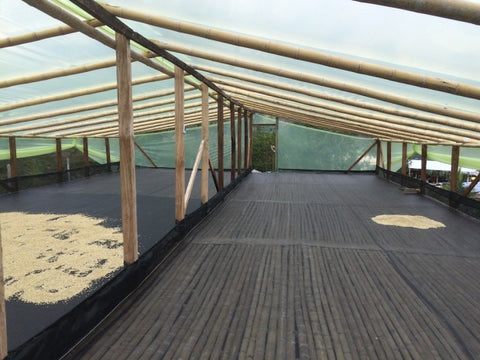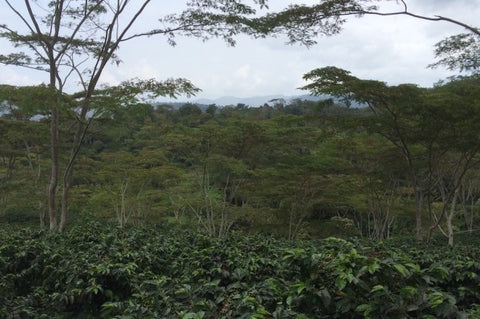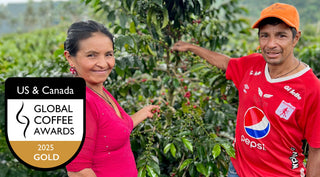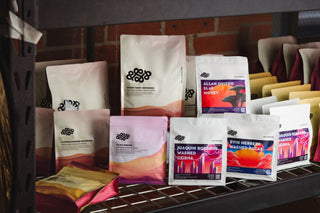I was in Colombia this past week visiting Martha Reina, the Guzman Brothers and Jose Martinez. Although I could write ad nauseam about each of the visits, I want to focus on my time with Jose Martinez. But before I dive into this last visit, I think it’s worth learning a bit about the story of how we began to work together.
My first meeting with Jose Martinez turned out to be a true reflection of his personality. I first met him in November of 2014, during a visit to Colombia. I was at the Virmax warehouse in Pitalito, Huila, when Javier Rojas, the agronomist for Virmax, introduced me to an energetic fellow. The introduction was impactful because Javier, whose opinion I value a great deal, introduced Jose as one of the most quality focused producers in the area. I was instantly impressed by Jose’s demeanour and thirst for knowledge.
Naturally, Jose asked me if I would taste his coffee, but I told him I had to leave for the airport within half an hour so it would be very difficult. Jose pleaded “wait for me, don’t leave!”, then jumped on his motorbike and sped out of the lot. He returned 29 minutes later with four green coffee samples and said, “please taste them in Canada and tell me what you think”. Days later, I cupped them with Phil and they were outstanding.
In May of 2015, I visited Jose’s farm and learned a little more about him. He was born on the very same coffee farm, where he first learned about coffee from his father. When he was 16 he decided to leave the farm and ended up becoming a bus driver. He did this for over a decade until he decided to return to the farm and follow in his father’s footsteps. Although he now regrets temporarily leaving the farm, he feels the time away developed a fire within him to become a better coffee producer. This fire was abundantly evident when visiting his farm. The farm is not overly planted and has plenty of natural shade. The trees look very healthy and well pruned.
I am starting to see that what separates Jose from most producers is his desire to do things right. When he built his fermentations tanks, he initially wanted to tile the entire room (walls, floor and ceiling) to create a very clean and presentable environment. Most quality focused producers manage to tile the fermentation tanks and that’s all, but for Jose that’s not good enough, it’s not presentable enough, not clean enough. For cash-flow related reasons, he is doing the improvements in stages, so he is not done with the tiling of the fermentation area, but he’s well on his way.
In May, I noticed that his drying infrastructure was holding him back. He was drying coffee on the roof of his house (a very common system used in Colombia with a rollaway roof called “Casa Elba”). Without me saying anything, he said “I know my drying is not good, I am going to build a proper patio, do you have any advice for me”? I was a bit shocked to hear him seek information so openly, as most producers tend to resist change. Having had some experience with successful drying projects in Colombia and other countries, I was happy to offer some suggestions. We chatted about drying for quite a while and then he told me “you will see great changes in my drying before you come back in November”.
During my visit this past week, I got to once again experience Jose’s quest for perfection first hand. When I pulled up to his house, I saw his new (nearly finished) drying structure. It’s a work of art. Once again, his desire to do things the right way was evident and impressive. I have seen many drying structures and Jose’s has a great deal of innovation and attention to detail. For instance, many producers fasten the plastic to the extremities and there’s always some leftover plastic that over hangs – although it doesn’t affect the function of the drying, it looks a bit untidy. In Jose’s case, the plastic was perfectly and neatly installed. With this help of his partner, Francy, he also devised a system for neatly raising and lowering the plastic curtains for increased airflow during the daytime. He is using shade in his dryer but it’s not permanently installed as he is working on spring based system for managing the shade curtain on top of his drying structure. Jose cares a great deal about his farm and processing always looking very neat and clean, as well as being easy to use and efficient. It’s truly impressive.

Standing with Jose and Francy on their drying patio

Jose’s new drying structure. Built with love and precision.
During the visit, Jose kept showing me things that he is going to improve. He has a clear vision and a desire to invest in his farm and infrastructure. It’s very refreshing to see and its impact is becoming very clear as I taste more and more of his coffee. Jose and I spoke about a three-year plan for the farm that includes drying improvements, wet mill improvements, planting different and interesting varieties and continuing to protect the soil. He often refers to his farm as a “garden” rather than a farm, I found this little detail very interesting.
I very much enjoy spending time with Jose and Francy. They are fun people, thirsty for knowledge, and determined to improve in every way. It also doesn’t hurt that they share my passion for good, local food. I now have to prepare before visiting the farm by not eating for 24 hours so that I can finish my very large meals at the farm.

Sancocho, home-grown chicken, avocado from the farm and salad.
Jose’s farm is in a small region in the south of Huila called Palestina. During this trip I also had an opportunity to explore Palestina and was impressed by the amount of shade still remaining in this area. It’s such a treat to see so much shade since the practice of growing coffee under shade has been all-but-lost in Colombia. I was able to spend time with Jose cupping his coffee and a number of his neighbours and was entertained as Jose was constantly keeping score and proud every time his coffee “defeated” his neighbours’ coffees on the cupping table, which happened every time we cupped. I can see that he is extremely proud and competitive. I am very happy to be working with Jose.
- Sebastian

A view of Jose’s farm with plenty of natural shade.







